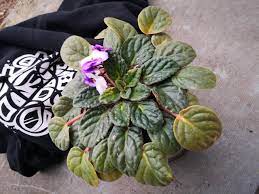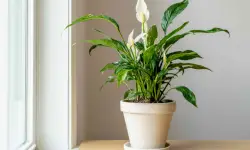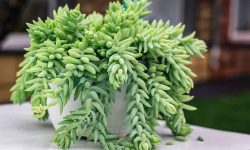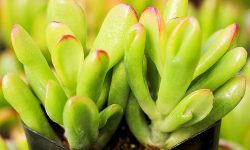African violets (Saintpaulia) are beloved houseplants known for their vibrant and delicate blooms. But nothing is more disheartening than seeing their leaves turn yellow. This phenomenon can be a cause for concern among plant enthusiasts since it may indicate an underlying issue that needs attention.
Understanding the various causes of African violet leaves turning yellow is crucial in maintaining the health and beauty of these charming plants. Explore possible reasons for this leaf yellowing problem with their effective remedies and preventive measures.

11 Causes of African Violet Leaves Turning Yellow
Too Much Sunlight
Excessive sunlight exposure can lead to African violet leaves turning yellow. These plants thrive in bright but indirect light, making them susceptible to leaf scorching when exposed to intense sunlight.
The UV rays can damage the leaves by causing yellowing and browning. It is crucial to move your African violets to a location with filtered or indirect sunlight. You can use sheer curtains or blinds to diffuse the light.
If the damage is mild, pruning the affected leaves can help promote new growth. It is advisable to monitor the sunlight exposure and adjust to ensure your African violets receive the optimal amount of light for their well-being.
Not Enough Sunlight
Insufficient sunlight can also result in yellowing African violet leaves. These plants require a balance between light and shade to thrive. Without adequate light, their chlorophyll production may decrease, leading to pale and yellowed leaves.
Ensure your African violets are placed in a well-lit area, preferably near a north or east-facing window where they can receive bright, indirect sunlight. Supplemental grow lights can also be used if natural light is limited.
Regular rotation of the plants can ensure even exposure to sunlight and prevent leaf yellowing. Avoid placing them in direct sunlight as it can cause leaf scorching. Striking the right balance between light and shade will promote healthy foliage growth and vibrant blooms.
Water on Leaves
Water on the leaves of African violets can contribute to yellowing. When water droplets remain on the foliage for an extended period, they can act as magnifying lenses, intensifying sunlight and causing leaf scorching.
Moisture on the leaves can create a favorable environment for fungal and bacterial diseases, leading to leaf discoloration. It is essential to water your African violets by ensuring that water is directed toward the soil and not sprayed directly on the leaves.
If any water droplets accumulate on the foliage accidentally, gently blot them with a clean cloth or tissue. Increasing airflow around the plants through proper ventilation can also help prevent excessive moisture buildup. By keeping the leaves dry, you can minimize the risk of yellowing and maintain the overall health of your African violets.
Lack of Nutrients
African violet leaves can turn yellow when they are deprived of essential nutrients. These plants require a balanced diet of macronutrients (nitrogen, phosphorus, and potassium) and micronutrients (iron, magnesium, and others) to maintain their vibrant foliage.
When nutrients are lacking, the leaves may exhibit signs of chlorosis, manifesting as yellowing between the veins while the veins themselves remain green. It is recommended to feed African violets with a balanced and specifically formulated fertilizer.
Look for fertilizers specifically designed for African violets and follow the instructions for application. Applying a diluted fertilizer solution during the plant’s active growing season can provide the necessary nutrients for healthy leaf development.
Regularly monitor the nutrient levels and adjust the feeding regimen accordingly to prevent nutrient deficiencies and maintain the lush green color of the leaves.
Soil Problems
Issues with the soil can also contribute to yellowing African violet leaves. Unsuitable soil composition or pH imbalance can affect nutrient uptake and root health, leading to leaf discoloration. African violets prefer well-draining soil with a slightly acidic to neutral pH (around 6.0 to 6.5).
If the soil is too compacted, waterlogged, or lacks proper aeration, it can hinder root function and cause yellowing. Ensure your African violets are planted in a well-draining potting mix specifically formulated for these plants.
Consider adding organic matter like peat moss or perlite to improve drainage and aeration. Regularly test the pH of the soil and adjust it if necessary. By providing a suitable soil environment, you can promote healthy root growth and prevent yellowing of the leaves.
Pest Infestation
The presence of pests on African violets can cause leaves to turn yellow. Insect infestations, such as aphids, spider mites, and thrips, can sap the plants of vital nutrients, leading to leaf damage and discoloration.
Some pests can transmit diseases that further weaken the plants. To address this issue, it is essential to regularly inspect your African violets for signs of pests. If an infestation is detected, treat the plants with appropriate organic or chemical insecticides, following the instructions carefully.
Isolating infested plants can help prevent the spread of pests to other healthy plants. Additionally, maintaining good plant hygiene, such as removing dead leaves and debris, can minimize pest habitats and reduce the risk of infestation.
Natural Plant Aging
Yellowing of African violet leaves can be a natural part of the plant’s aging process. As the lower leaves age and become less efficient in photosynthesis, they may turn yellow and eventually die off.
This is a normal occurrence and should not be a cause for significant concern unless it affects a large number of leaves simultaneously or spreads rapidly to newer growth. To manage this, regularly remove the yellowing leaves by gently plucking them from the base.
This will not only improve the plant’s appearance but also redirect its resources to healthier foliage. Providing optimal care, including proper lighting, watering, and nutrient supplementation, can help slow down the natural aging process and extend the overall lifespan of your African violets.
Too Little Water
Insufficient watering can cause African violet leaves to turn yellow. These plants require consistent moisture, and if they do not receive adequate water, the leaves may wilt and lose their vibrant color.
It is essential to water your African violets thoroughly when the top inch of the soil feels dry. Ensure that the water reaches the root zone and drains properly, preventing waterlogging.
Using room temperature water is advisable to avoid shocking the plants. Self-watering pots or wicking systems can be useful in maintaining consistent moisture levels. Increasing humidity around the plants through methods like using a pebble tray or a room humidifier can help prevent excessive water loss through the leaves.
Humidity Issues
African violets thrive in environments with moderate to high humidity levels, and insufficient humidity can lead to yellowing of the leaves. Low humidity can cause water loss through the leaves, leading to dehydration and leaf discoloration.
Consider increasing the humidity around your African violets. Methods such as placing a tray of water filled with pebbles beneath the plants or using a room humidifier can help raise humidity levels. Grouping plants together can create a microclimate with higher humidity.
Avoid placing the plants near sources of dry air, such as heaters or air conditioners. By maintaining adequate humidity, you can prevent moisture loss and keep the leaves healthy and green.
Crowded Roots
When African violets become root-bound or have crowded roots, the leaves may turn yellow. Over time, the compacted root system can restrict nutrient uptake and water absorption, leading to leaf stress and discoloration.
It is crucial to repot your African violets periodically, especially when you notice signs of root crowding or limited growth. Gently remove the plant from its pot and carefully untangle and prune any circling or compacted roots.
Repot the plant into a slightly larger pot with fresh, well-draining soil, ensuring that the roots have enough space to grow and spread. Avoid using pots that are excessively large, as this can lead to waterlogging and root rot.
Overwatering
It is a common mistake that can result in African violet leaves turning yellow. These plants are susceptible to root rot and other fungal diseases when exposed to consistently wet conditions. When the roots are deprived of oxygen due to waterlogged soil, the leaves may wilt, turn yellow, and eventually die off.
It is crucial to establish a proper watering routine. Water your African violets thoroughly but allow the top inch of the soil to dry out before watering again. Use well-draining soil and pots with drainage holes to prevent waterlogging.
Ensure that excess water is allowed to drain away, and empty the saucer or tray beneath the pot to avoid stagnant water. Monitoring the soil moisture levels and adjusting the watering frequency accordingly will help prevent overwatering and maintain healthy leaves.
Final Thoughts from Experts
Yellowing African violet leaves can be a cause for concern, but with proper understanding and care, this issue can be addressed effectively. By identifying the underlying causes, you can take the necessary steps to rectify the problem.
Providing optimal growing conditions like suitable lighting, well-draining soil, proper watering practices, and adequate nutrition, is crucial for maintaining the health and vibrancy of African violet leaves.
Regular monitoring, preventive measures, and timely intervention, when issues arise, will ensure that your African violets showcase their beautiful green foliage, delighting you with their graceful presence.
People Who Read This Also Read:
- African Violet Leaves Turning Brown (Causes & Solutions)
- Brown Spots on African Violet Leaves (Causes & Solutions)
- African Violet Not Flowering (Causes & Solutions)
- How to Care for African Violets Indoors
- African Violet Leaves Falling Off (Causes & Solutions)
- African Violet Leaves Drooping (Causes & Solutions)
- African Violet Leaves Curling (Causes & Solutions)






